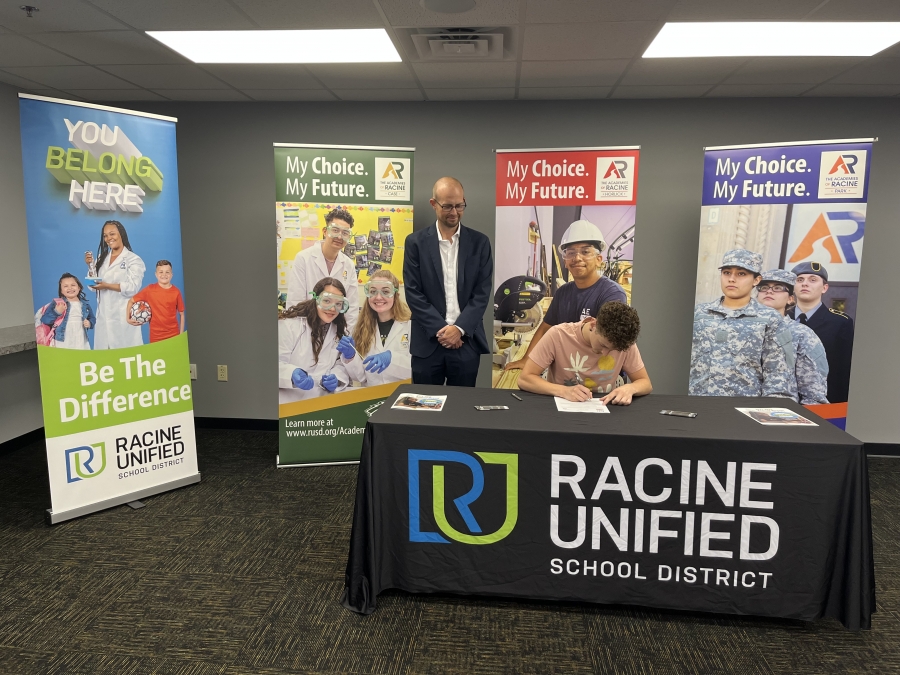Racine Unified School District - Academies of Racine
New Apprenticeship Benefits Students and the District
Not long ago, Racine Unified School District (RUSD) made news by hosting the first of its kind, custom site visit for representatives of Fayette County Public Schools (FCPS), Lexington, Kentucky and the Academies of Lexington. Well, RUSD’s Academies of Racine is back in the news with another first. This time it’s a first for students within the education pathways at Case, Horlick and Park high schools who are interested in careers in education. This fall they will be able to take advantage of a formal Youth Apprenticeship (YA) in education to gain hands-on experience, college credits, and a little income to boot. But that’s not all! Add to that, the student apprentice receives a guaranteed opportunity to be a Racine Unified School District teacher upon college graduation and a $5,000 signing bonus! Read more about how this new opportunity for students became a reality and how it is a big win for both the students and the district.
New Apprenticeship Benefits Students and the District
Like all Ford NGL communities, Racine Unified School District’s Academies of Racine offers a variety of pathways to help students prepare for a specific career area while meeting the mandatory requirements for high school graduation. Students gain real-world experiences with local businesses and professionals, linking schoolwork and the workplace. Students can also earn industry certifications and college credits while in high school.
The Wisconsin Department of Workforce Development (DWD) also offers apprenticeship opportunities to high school juniors and seniors through its Youth Apprenticeship (YA) program. The program is facilitated by Racine Area Manufacturers and Commerce (RAMAC) in collaboration with RUSD. The benefits for students participating in one of the 11 broad YA pathways include a paycheck, hands on training, a more relevant learning experience, access to possible career opportunities, and certification. That has been great for those in an DWD approved area of study, but, while students in the Academies of Racine education pathway were able to earn employability and leadership certifications as well as earn college credits while assisting in K-8 classrooms, they were not eligible for state approved youth apprenticeships. The good news is that for academy students who want to be teachers, like recent graduate Eric Rannow Jr., that all changed with the 2023-24 school year.
To tell us all about the new education apprenticeship, how it came about, and what it means for everyone involved we talked to Eric Rannow, Jr., student; Jody Bloyer, Chief of Schools and Melissa Abel,Deputy Chief of Human Resources for RUSD;Alex DeBaker,Executive Director of Academies & Transformation, Academies of Racine; and Michael Lynch, Workplace Learning Coordinator, Park High School.
The Youth Apprenticeship (YA) Program has funding for 225 students, at $1,000 per student, which goes toward equipment, FTEs and training. In the 2022-23 school year, Academies of Racine had 212 student apprentices which was up from 185 in the previous year. We asked Alex DeBaker how the possibility of adding an education apprenticeship to their strong program first came about. Alex recalled, “A majority of our career pathways have a youth apprenticeship, but education did not. In the beginning, Mike and I were sitting around one day just brainstorming. What can we do to give our education pathway the same opportunity as those with apprenticeships? I mean, after all we are a school district, and they're in the education pathway. Why can't we do some sort of internship? So that's pretty much how it got started, and we sat down with our workplace coordinators and drew up a plan. We were able to arrange internships in the schools. That provided students with the needed experience and allowed them to earn employability certification and employability skills certification through the Wisconsin Department of Public Instruction (DPI). We were able to make it structured like an apprenticeship plus students could walk away with something more than an entry on the resume.”
Alex continued, “Another reason for the internship initiative was the opportunity to encourage more diversity in the teaching field in our community. There's plenty of data that shows that our students need teachers that look like them. For example, some of the data says if young black male students have a teacher who looks like them, they're 30% more likely to graduate high school. Other data says if they have two teachers that look like them, they're 60% more likely to graduate high school. We need students from our community to want to be teachers in our community to build successful schools.” Melissa Abel added, “Yes, we need diversity, but I think we also have to take a step back and consider the overall national teacher shortage.And we know that people who are going to teach in this area may be people who are from this area. That’s why we really want to take advantage of keeping in contact with our students after high school and continue to develop that relationship. It is not just something that ends after high school, and then we somehow try to miraculously get you back in four years. We want to keep that relationship going throughout the whole process.” Jody Bloyer, Chief of Schools agreed, “To me, creating the internship was all about the students. It was all about the young people and seeing just what an investment they are, the value of who they are, and what they can bring to this legacy of education that we're all in.”
“We just made a big push last year by transitioning our education pathway from what was more of an early childhood type pathway to be more aligned to our post-secondary partner,” said Alex. ”We actually built an articulation agreement between the University of Wisconsin-Parkside and Carthage College. That means our students are now taking courses that go towards a DPI license, where in prior years, they were not. When they get to post-secondary, if they would like to be a teacher, they've already earned roughly 12 to 15 credits. That is a big advantage, plus, that's a huge tuition savings for the student.”
“Obviously we all had to work together to make these internships happen. We worked with Melissa and her team in Human Resources and with Jody as the Chief of Schools and the deputy chiefs which oversee the K-8 in our school district. They had to agree to sending students into their schools. Then we worked with the principals and teachers, and Mike worked with the interns and the teachers on evaluations and things of that nature. As far as recruiting and student mix in the program, the demographics of our education pathway are already very diverse. There is a little more of a female presence in the pathway, and encouraging more males to join is something that we will be working towards. There are some other marketing and recruiting ideas out there, and we're working with a couple of our partners to see what is possible. For example, there may be ways of recruiting African American males in the pathway while they are still in middle school. We also work with Carthage and UW-Parkside, and they help represent with diverse candidates. They actually host an urban-education, professional development event for our students. We want young people to know that teaching is an attractive career. It's not necessarily going to be about the pay, but it is an important role in society and a personally rewarding career option.”
We asked Michael Lynch, Workplace Learning Coordinator, about when and how the education internship was rolled out. “It all happened rather quickly,” said Michael. “I think we announced the availability of the internship option in late September, early October of 2022 to seniors. Typically, it works best for seniors because of the credit requirements and their schedule flexibility. We went in and talked to the classes and to the students who showed interest. We worked with their pathway teachers to confirm the group of students who would participate. Then we worked with the different schools to find a good fit depending on what each student was looking to get into — whether it was special education, K-4, middle school, whatever it might be. Eric was one of those students who expressed interest and he jumped right in.”
“Of course, once Melissa came back with the internship parameters and approvals from the district, we then sent it out to the principal at each of our two elementary middle schools. They needed to know what the plan was and what our objectives were. Then from there, it was about finding teachers that were interested in bringing on a student in their classroom. We didn't want this to be forced on anybody. We wanted this to be a natural, organic process, so once we got a list of teachers who were interested, we gave them a call and again went through what the expectations were from them and from our students. From there we interviewed the students collectively and found what we thought would be the best learning situation for each of them. We also felt that it was important that the classroom selected wasn't forced on anybody.” Alex added, “We wanted to find a spot where Eric and the others felt comfortable including the staff and teachers at the participating schools. If we were forcing it, we felt we were going to lose some of the value of the program.”
As we talked to the group, we wanted to know how the actual internship experience was from a student perspective. We asked recent graduate, Eric Rannow Jr., who is now attending the University of Wisconsin-Whitewater,what the internship was like for him. “I've been wanting to be a teacher since I was really, really young,” said Eric. “It's just always been my passion. It has always been something that I knew that I wanted to do. I found out about it from my education pathway teacher, Mrs. Schmidt. As far as the actual internship, I worked in a special education classroom. I had never even thought about that option before, but thenagain,that's one of the reasons I did it. I knew it was something I had not experienced, and I wanted to get that experience. Then, when I was with the kids, it was instantly so cool! It was like they were all so innocent, and they were also very determined to learn. I learned a lot too about how to communicate with students and other teachers. There was a lot of self-discipline required too and a lot of patience. It was something that I knew was going to be a big part of it, but experiencing it was a whole other thing. Everything that I heard about the classroom in my high school education classes was helpful. At the same time, I had no idea what it was really like. When I got there on the internship, it was really eye opening. Now I’m going to college and when I get my degree, hopefully I can come back to Racine and teach. I love my community, so if possible, coming back is a top priority.”
We asked the group if it was because of their internship efforts that DWD is now including teaching in their youth apprenticeship program. “Well, it would be nice to take the credit for that, but I don't know if it's a direct result of our work,” replied Alex. “What’s important, however, is that they too see the need for teachers, and we already have the internship program in place.” Michael pointed out, “The apprenticeship does require 450 hours to meet the DWD requirement, which is up from the 180 we started the internship with. The students earn the college credits and the two certifications.” Melissa added, “One of the unique things we have is a little ceremony at the end where they sign a letter of intent with us. That letter of intent states that when they finish their program and their degree to get their licensure, they are going to have a guaranteed position with Racine Unified School District. When they return, they'll be placed on the salary schedule, and their employment comes with a $5000 bonus and a three-year retention. So far, we've given out 17 letters of intent including the one to Eric. This is a commitment that they're making to us, and we to them.” Michael reflected, “For us, that was like the ultimate icing on the cake. We just wanted to be able to get the students into the classrooms, and we wanted to give them the experience. It is such a valuable piece and one that we didn't even think about before proposing the program to HR. I can imagine for somebody like Eric, when you're getting to your junior senior at college, you start thinking about graduation. One of the biggest stressors at that time is finding employment. Having that peace of mind during those four years of college is a huge plus.”
Key Learnings/Takeaways
- Define and articulate your “why and how” to all key stakeholders. “We sat down with our workplace coordinators and drew up a plan. We worked with Melissa and her team in Human Resources and with Jody as the Chief of Schools and the deputy chiefs which oversee the K-8 in our school district. Melissa came back with the internship parameters and approvals from the district, and we then sent it out to the principals at both our elementary middle schools. We talked to the classes and to the students who showed interest. We worked with pathway teachers to confirm the group of students who would participate and then with the different schools to find a good fit. We got a list of teachers who were interested, we gave them a call and went through again what the expectations were from them and from our students. We worked with the principals and teachers, and with the interns and the teachers on evaluations and things of that nature.We actually built an articulation agreement between the University of Wisconsin-Parkside and Carthage College.”
- Focus on what is needed and what can be done. “For communities in the Ford NGL Network thinking about creating internships and adding apprenticeships, especially in education, I want to say, it can be done. Sometimes we get so hung up on what we see as roadblocks like policies and procedures and such. It makes us think like, oh, it's never going to happen. From the time we had that first conversation about an internship in the education pathway, we literally had the internships up and running the next school year. It can happen,” said Michael.
- It takes action to add value. “On this initiative, everybody understood the value. When you just think about it and do not act, there is no way to know what is possible. You have to just do it. Start writing it up, get it out there, and go from there, because it can be done.” said Michael. Alex added, “Jody and the leadership team had enough courage and confidence in us to make this decision. They did so without asking too many questions, because they had trust and faith in us and there was trust across departments. Collectively we also knew the value of the program for our students. If you are going to carry out the academy model with fidelity, our education students need this real-world experience.”
- When students win, the district and the community can win too. “From a human resources point of view, it was kind of a no-brainer,” said Melissa. “First, there is the value it brings to our students right now. Second, there is not much of a risk, but there is the potential for a real win-win situation. Consider that we are just two weeks away from school starting, and we still have 30 teacher vacancies to fill. This is just one way we can help address the teacher shortages we face.”
- Progress does not require perfection. Jody summed it up this way, “I know that over time they'll get all of the systems and processes in place and refined. To me, what's most important and what's going to keep this going is our shared vision of making a short-term and long-term investment in our young people. Our young people, I hope, believe that we are invested in them in the moment — that short-term investment of giving them opportunities, right? What I want is for our young people to see that not only are the schools invested in them today, but our community is also invested in them for the long term. What better opportunity than to have someone who grows up in a community, come back and serve in that community as a teacher?”
- When planning internships and apprenticeships, get buy-in from the mentoring teachers and make sure you interview thoroughly for a great match. When Alex reflected on the student placement process he said, “Teachers need to know the plan and the objectives. From there, it is about finding teachers who are interested in bringing on a student in their classroom. We don’t want internships or apprenticeships to be forced on anybody. We want this to be a natural, organic process. The first time through we interviewed the students collectively and found what we thought would be the best learning situation for each student. We felt that it was important that the classroom selected wasn't forced on anybody. We still feel that way, but this year, we believe the process can be improved if reversed. The principal and the mentoring teachers will do the interviewing. We have come to the belief that it is not the best practice for us to place the students. The mentoring teacher should have more of a say about the student they will be mentoring. The school will own the hiring process, so they get to know the student in advance through the interview process.”


